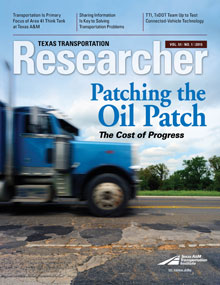The Lone Star State is facing future challenges that cut across traditional lines of thinking and require cross-cutting solutions as well. The Texas A&M University System has created the Area 41 Institute to help solve these multidisciplinary problems.

The Institute’s name is a nod to the military installation called Area 51, which is known for developing innovative aircraft, as well as the fact that Texas A&M University is home to the presidential library of George H. W. Bush, the 41st president of the United States.
“Area 41 is a university-based think tank aimed at identifying and helping to solve seemingly intractable issues in Texas’ future,” says Bill Stockton, Texas A&M Transportation Institute (TTI) executive associate director. “I don’t believe anything like it has ever been developed before at the university level, and TTI is excited to be a part of it.”
Area 41’s mission is to “foster and support collaborative research and education across The Texas A&M University System on critical issues facing the state of Texas and the nation in the next three decades.” Specific focus areas include transportation, water, energy, health care, education, and food safety and security.
“The A&M System is already well known for its research capabilities, especially in the areas of transportation, agriculture and energy — many of the same fields that have been identified as having critical challenges going forward,” A&M System Vice Chancellor for Research Jon Mogford explains. “Area 41 will allow our exceptional staff to look beyond the horizon and make a real impact on our future quality of life.”
The Texas state demographic projects that the state’s population will grow from its current 26 million to more than 40 million by 2050. With congestion already a huge issue for many urban areas, how do we ensure mobility with nearly 15 million more people? How will we meet their freight needs? What about water availability? Will we be able to reliably feed everyone?
“Many of these looming problems are intertwined, so it makes good sense to determine where these problems intersect and, in the long term, come up with solutions before we reach a crisis,” Stockton notes.
Most university research is conducted to meet a sponsor’s need to address an immediate, specific problem. Typically, no money exists to deal with future problems, even if they can be foreseen decades in advance. To initiate funding for this new research process, $1 million was allocated to Area 41 in the A&M System budget. Officials anticipate funds from state, private and non-profit sources that share concerns about the future of Texas and, by extension, the nation.
“We think Area 41 can become an expert panel for policy makers and legislators, providing input on how their decisions might impact our future,” Mogford says.
